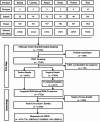Prevalence and comorbidity of attention deficit hyperactivity disorder in Chinese school-attending students aged 6-16: a national survey
- PMID: 40223102
- PMCID: PMC11995565
- DOI: 10.1186/s12991-025-00558-w
Prevalence and comorbidity of attention deficit hyperactivity disorder in Chinese school-attending students aged 6-16: a national survey
Abstract
Background: Attention deficit hyperactivity disorder (ADHD) is a prevalent neurodevelopmental disorder. Despite its significance, no large-scale epidemiological study assessing ADHD, and its associated comorbidities in children and adolescents has been conducted in China.
Methods: Within a national epidemiological survey of 73,992 children and adolescents aged between 6 and 16 in China, we used the CBCL, MINI-KID, and DSM-IV to identify ADHD and its comorbid conditions. Chi-square tests were utilized to compare the prevalence estimates across varied age and sex groups.
Results: The overall ADHD prevalence was estimated at 6.4% (95% CI: 6.2-7.0%). Broken down by subtypes, ADHD-I had a prevalence of 3.9%, ADHD-C was at 1.7%, and ADHD-H was at 0.9%. Boys and the younger age bracket recorded higher prevalence rates for ADHD and its subtypes (p < 0.001). Among ADHD-diagnosed individuals, 53% exhibited at least one comorbid psychiatric disorder. Oppositional defiant disorder/conduct disorder (ODD/CD) was the most prevalent comorbidity for ADHD-C and ADHD-H, at 58%, while anxiety disorders, at 17%, were predominant among ADHD-I cases. ODD/CD was notably higher among younger subjects (p < 0.001). In contrast, anxiety disorders were more frequent in older children and in girls (p < 0.001). Tic disorders showed a higher prevalence in younger boys, whereas mood and substance use disorders were more common in older boys (p < 0.001).
Conclusions: ADHD is a common neurodevelopmental disorder with high comorbidity rates that vary substantially across subtypes, age, and sex. These clinical heterogeneities complicate management and highlight the need for tailored interventions.
Keywords: ADHD; Children and adolescents; Comorbidity; Prevalence.
© 2025. The Author(s).
Conflict of interest statement
Declarations. Ethics approval and consent to participate: All participants and their parents provided informed consent prior to participation in the study. The study adhered to the principles of the Declaration of Helsinki and received approval from the Ethics Committee of Anding Hospital, Capital Medical University (Project identification code: 2012BAI01B02). Competing interests: The authors declare no competing interests.
Figures



Similar articles
-
The prevalence of psychiatric disorders among students aged 6~ 16 years old in central Hunan, China.BMC Psychiatry. 2018 Jul 28;18(1):243. doi: 10.1186/s12888-018-1823-7. BMC Psychiatry. 2018. PMID: 30055590 Free PMC article.
-
Does oppositional defiant disorder have temperament and psychopathological profiles independent of attention deficit/hyperactivity disorder?Compr Psychiatry. 2010 Jul-Aug;51(4):412-8. doi: 10.1016/j.comppsych.2009.09.002. Epub 2009 Dec 21. Compr Psychiatry. 2010. PMID: 20579516
-
Prevalence of ADHD and Its Comorbidities in a Population-Based Sample.J Atten Disord. 2021 Jun;25(8):1058-1067. doi: 10.1177/1087054719886372. Epub 2019 Dec 13. J Atten Disord. 2021. PMID: 31833803
-
The Psychosocial Outcome of Conduct and Oppositional Defiant Disorder in Children With Attention Deficit Hyperactivity Disorder.Cureus. 2020 Aug 2;12(8):e9521. doi: 10.7759/cureus.9521. Cureus. 2020. PMID: 32905151 Free PMC article. Review.
-
Comorbidity of attention-deficit/hyperactivity disorder with psychiatric disorder: an overview.J Clin Psychiatry. 1998;59 Suppl 7:50-8. J Clin Psychiatry. 1998. PMID: 9680053 Review.
References
-
- Association AP. Diagnostic and statistical manual of mental disorders, 5th edition. Washington: American Psychiatric Association. 2013.
-
- Thapar A, Cooper M. Attention deficit hyperactivity disorder. Lancet. 2016;387(10024):1240–50. 10.1016/s0140-6736(15)00238-x. - PubMed
-
- Association AP. Diagnostic and statistical manual of mental disorders, 4th edition. Washington: American Psychiatric Association. 1994.
-
- Klassen AF, Miller A, Fine S. Health-related quality of life in children and adolescents who have a diagnosis of attention-deficit/hyperactivity disorder. Pediatrics. 2004;114(5):e541–7. 10.1542/peds.2004-0844. PubMed PMID: 15520087. - PubMed
-
- Biederman J, Petty CR, Woodworth KY, et al. Adult outcome of attention-deficit/hyperactivity disorder: a controlled 16-year follow-up study. J Clin Psychiatry. 2012;73(7):941–50. 10.4088/JCP.11m07529. PubMed PMID: 22901345. - PubMed
Grants and funding
LinkOut - more resources
Full Text Sources

